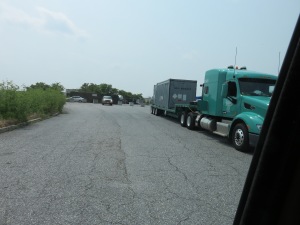Emma Wong
Project Manager
 If you have ever wondered about the safety of packaging and transporting radioactive materials, now is the perfect opportunity to learn about it. The NRC is kicking off the process of updating our requirements in 10 CFR Part 71.
If you have ever wondered about the safety of packaging and transporting radioactive materials, now is the perfect opportunity to learn about it. The NRC is kicking off the process of updating our requirements in 10 CFR Part 71.
We do this periodically to reflect new information. Changes to international packaging and transportation standards published by the International Atomic Energy Agency, which serve as a standard for the U.S. and other nations, can also trigger revisions. Stringent safety requirements, as well as coordination among federal agencies, international regulators, and tribal, state and local officials, help to ensure radioactive materials shipments are made safely.
The U.S. Department of Transportation has primary responsibility for regulatory materials transport, while the NRC regulates packages for larger quantities. This structure provides many layers of safety.
When it is time to review our requirements, the NRC coordinates with DOT to ensure the two agencies have consistent regulatory standards. The process may take several years. We are also working to align our regulations with the IAEA’s.
To encourage public input, we are publishing an “issues paper” that outlines areas we have identified for possible revision. We’ll take comments on it for 60 days. We plan to use that input to develop a draft regulatory basis—a document that identifies a regulatory issue, and considers and recommends a solution. Once finalized, the draft regulatory basis will be made available for public comment. After taking comments on the draft, we can publish a final regulatory basis.
At that point, if our Commission agrees that revision to our requirements are needed, we would move into developing a proposed rule, then a final rule. Each step in the process takes about a year. Details on how to submit comments can be found in a Federal Register notice that will be published on November 21. This information and additional details about the rulemaking will be available on the federal rulemaking website.
We’re also planning a public meeting on Dec. 5-6 at NRC headquarters in Rockville, Md., to discuss the paper and answer questions. Details on participating, including by teleconference and webinar, can be found in our meeting notice.
 While the regulations are being updated, the fact remains that radioactive materials are transported safely all the time. Millions of these shipments are made each year and arrive at their destination without incident. Occasionally, a carrier might be involved in a traffic accident. But in decades of experience, there has never been an accident that resulted in injury from exposure to the radioactive contents.
While the regulations are being updated, the fact remains that radioactive materials are transported safely all the time. Millions of these shipments are made each year and arrive at their destination without incident. Occasionally, a carrier might be involved in a traffic accident. But in decades of experience, there has never been an accident that resulted in injury from exposure to the radioactive contents.
All shipments of radioactive material must also be made in compliance with DOT regulations. Smaller shipments pose extremely low risk. The larger the amount of radioactive materials, the more stringent DOT’s requirements are. DOT limits how much radioactivity can be transported in each package. That way, no transport accident involving these shipments would pose a significant health threat.
But what about larger amounts of radioactive materials? What about spent nuclear fuel?
In addition to meeting DOT requirements, larger shipments of radioactive cargo such as spent nuclear fuel and fissile material must meet NRC regulations for packaging and transport in Part 71. These regulations include very detailed requirements for shipping under normal conditions, as well as stringent tests to show the packages can withstand hypothetical severe accidents. These are the regulations we are updating now. If you would like to learn more about the transportation of spent fuel and radioactive materials, see our website.

 The library makes the discovery documents by various parties to the hearing public for the first time in five years, and with enhanced search capabilities. The new
The library makes the discovery documents by various parties to the hearing public for the first time in five years, and with enhanced search capabilities. The new